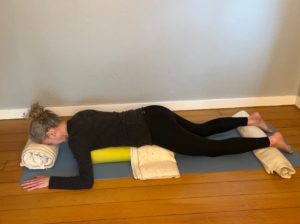
by Leslie Howard
This special restorative pose is a supported version of Prone (Face Down) Savasana, where the torso and head are supported so they are higher than the legs. I myself often start and end my practice with this pose because I find that being face down is very soothing for me and it helps me turn away from the outside world and focus my awareness internally.
This pose has so many benefits, including:
- Quieting your mind and nervous system.
- Having your thighbones hang off the support helps release the hips and tractions your lower back, reducing lower back pain.
- Bringing your awareness into the back of your body so you can relax and release tension from areas where breath/prana isn’t flowing.
- For some people, lying face down makes them feel safer than lying face up, especially if they are anxious or are feeling vulnerable, so it may be a better relaxation pose for some than Supported Savasana.
You can do this pose with several different types of supports, such as a bolster, two or three blankets folded lengthwise, or even a firm sofa cushion. Just make sure that the support under your torso is firm, not mushy. Have two extra blankets or towels to support your head and ankles.
Timing: 5 to 15 minutes. The longer you spend in the pose, the more effective it is.
Caution: The only time this pose is NOT a good idea is if you have just had food or are on the first few days of your menstrual cycle. If you find that being face down makes you feel claustrophobic, come out of the pose and try Supported Savasana (see Featured Restorative Pose: Supported Relaxation Pose) instead.
Setting Up for the Pose
Start by placing the bolster, stack of blankets folded into long, thin rectangles, or whatever prop you’ll be using to support your torso lengthwise on your mat.
Then fold one of your blankets into a large rectangular shape and roll it into a skinny roll. Place the blanket roll where your feet will be.
Finally, roll your second blanket into a thick roll that is slightly lower in height than the bolster and place that roll where your forehead will be.
Getting Into the Pose
Come into a hands and knees position with your knees a few inches in front of the bolster and your hands on either side of it. Then move the skinny rolled blanket under the fronts of your ankles.
Now you’re ready to lower yourself onto the bolster. As you do so, shift forward to align the middle of your sternum (the T-shaped bone in the front of your upper chest) with the top edge of the bolster. Allow your head to release toward the ground and place your forehead (but not the rest of your face) on the rolled blanket, moving the blanket roll if necessary. Having only your forehead on the support prevents your nose from being squashed. You can adjust the height of the prop under your forehead but ideally the head is slightly lower than the torso.
Position your arms in a cactus position with palms facing down.
Practicing the Pose
After you settle into the pose, turn your attention to your breath. Consciously slow and deepen your breath so you feel movement all the way to your pelvic floor. As if you were filling a glass of water, allow your inhalation to fill your torso from the pelvic floor up to the collarbone. Exhale naturally.
After a few breaths, turn your focus to your spinal muscles, from the top of your sacrum to your upper back. On each inhalation, notice if movement anywhere in your back body is constricted or if one side moves more easily than the other. When you exhale, invite the constricted areas to release.
Stay in the pose for 5 to 15 minutes. When you’re ready to come out, slide your hands next to your chest and push yourself back into a hands and knees position. Then slide your hips back into Child’s pose, resting your forehead head on a bolster. Stay as long as you like in Child’s pose and then slowly come up to sitting.
Variations
If you have large or sensitive breasts, you can place an extra blanket or two lengthwise on the bolster, with the top edge of the blanket just below the level of your breasts. That will make more space for your breasts so there is less pressure on them.


If you have a more sway in your lower back (anterior tilt) and/or you feel any compression in your lower back while in the pose, place a folded towel or blanket width-wise on the bolster where it will support the lower part of your torso, from your navel to your pubic bone. This will create more height and support for your lower back.



Leslie Howard is an Oakland-based yoga teacher, specializing in all things pelvic as well as other therapeutic applications of yoga . She leads workshops and trainings nationally and has written a book about caring for the female pelvis, Pelvic Liberation. She is a regular presenter for the Yoga Journal conferences and a regular contributor to Yoga Journal magazine. Her own struggles with healing her hips and pelvis led her to intense study of the anatomy, physiology, cultural messaging, history, and energetics of this rich area of the body. Her teaching is informed by over 3500 hours of yoga study with senior Iyengar yoga teachers. She considers Ramanand Patel her most important influence and mentor. She has designed two very successful studies for UCSF on how to use yoga to alleviate incontinence and pelvic pain. Find her at lesliehowardyoga.com.
• Follow Yoga for Healthy Aging on Facebook and follow Nina on Instagram • Order Yoga for Times of Change here and purchase the companion videos here • Order Yoga for Healthy Aging: A Guide to Lifelong Well-Being here.


Wonderful suggestions, Leslie! I particularly loved your easy ideas for varying for different body types – I have APT myself, so I found that particularly helpful.